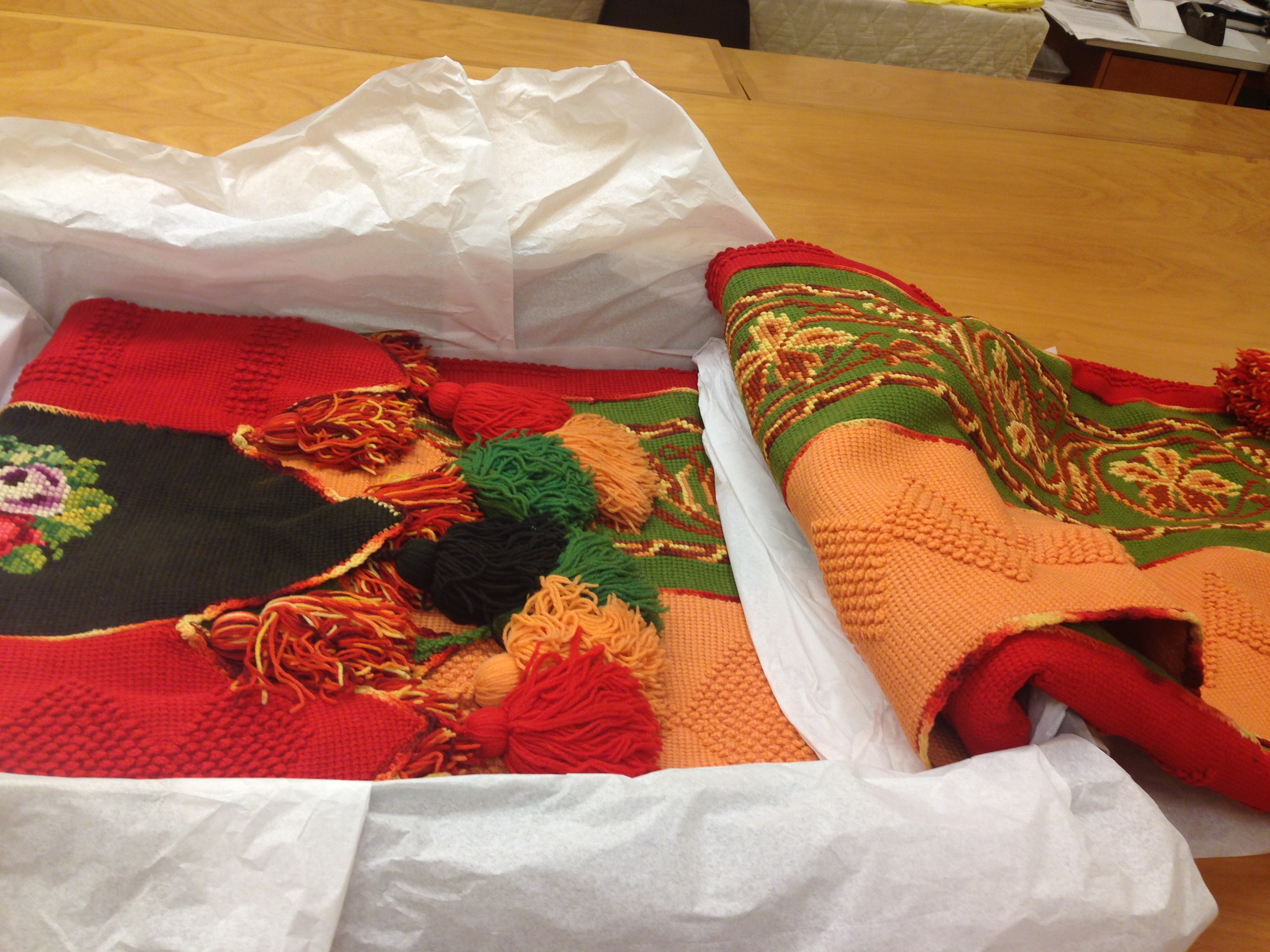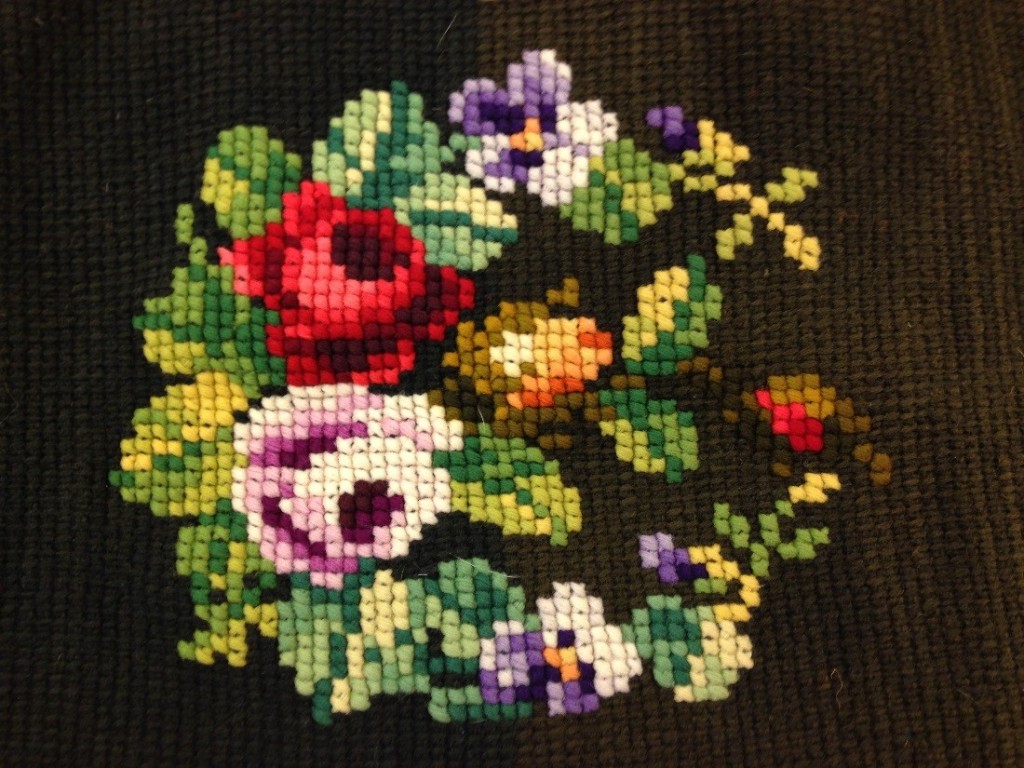Afghan for the Ages: A Walk through WPAMC Textiles Connoisseurship Research
Mary Corson Harvey, Detail of Afghan Embroidery, ca. 1873. Wool, crochet and embroidery. 2014.0020, Winterthur Museum
Imagine with me if you will, that it’s October of 1873 in Bucks County Pennsylvania. You are twenty-four-year-old Mary Eileen Corson, feeling nervous and excited about your upcoming marriage. Sitting by the fire, you pull out brightly colored wool, a crochet hook, and the afghan you’re preparing as a carriage robe for your wedding.
We can’t know for certain what Mary Corson Harvey was thinking or feeling while she constructed her afghan, but we can study the afghan as a material document of the past. The textile’s physical properties tell us about its creation, ownership, and use within a particular cultural and historical context.
Textiles Connoisseurship is a chance for first-year WPAMC students to learn more about the materials, techniques, and histories of the textiles collection at the Winterthur Museum. This year, each student selected a textile object in the collection to research over the course of eight weeks. I selected an 1873 Pennsylvania afghan pictured below.

Photograph of the afghan in its textiles storage box. Mary Corson Harvey, Afghan, ca. 1873. Wool, crochet and embroidery. 2014.0020, Winterthur Museum
After selecting an object to research, where does the connoisseur begin? My first step was to spend time looking closely at the afghan and noting what I saw. I noted the construction, materials, condition, design, and evidence of use. This exercise helped me to start asking questions of the object. For example: where are the design patterns from? What kinds of stitches were used to construct each panel? How was this object used in its original context? Who’s initials decorate the central panel?
Diagram of the afghan. Courtesy of the author.
The next step in researching the afghan was to consult the museum object file. The file contained information on provenance and previous research. I found a family story citing the donor’s great-grandmother as the creator of the afghan, for her wedding day in 1873. The initials MEC from the central panel corresponded with the maiden name of the donor’s great-grand mother Mary Eileen Corson. This discovery opened the door for further avenues of questioning: If Mary Eileen Corson did make this afghan for her wedding day, what were her design and color influences? Where might she have gotten her materials from?
From there, I consulted primary and secondary sources to provide historical and design context. Periodicals and fancy-work manuals from the last quarter of the nineteenth century published numerous knit and crochet patterns targeted toward women in a domestic setting. In addition to instructing the reader in fancy work, they also commented on what to make and why. Patterns covered a wide range of domestic articles, from clothing to household furnishings. Crochet and embroidery comprise only a small portion of the various fancy work skills employed in the patterns published in magazines such as Godey’s Lady’s Magazine, Cassell’s Magazine, and Harper’s Bazaar. The Ladies Fancy Work, a needlework guide published in 1876 states,
“Of all worthy ways or noble efforts to improve the Home life of the American people, what more encouraging and appreciative field is there, than this of careful, conscientious devotion to the pleasures, recreations, and attractions of the Household? The little lady of the house, its mistress, longs ever for the delightful moments of each day, when, with busy fingers, she can add the tasteful touches, here and there, which will make the Little Realm more enticing.” – Mrs. C. S. Jones, Ladies’ Fancy Work: Hints and Helps to Home Taste and Recreations (New York: H.T. Williams, 1876).
“Carriage or Cradle Afghan: Crochet and Cross Stitch Embroidery,” Harper’s Bazaar 6 (August 9, 1873), p. 501. Original from the University of Michigan.
Patterns offer information about design sources and techniques from the period. They provide context for understanding what kinds of designs circulated and how.
Crochet patterns often include an image of the finished product with written instructions on required technique and supplies (above). Embroidery patterns in periodicals appear printed in black and white on a grid with symbols or watercolor indicating color application.
Detail of afghan embroidery. Mary Corson Harvey, ca. 1873.
The Winterthur Museum contains several examples of needlework patterns that closely resemble the floral needlework in the central black panel (above). These patterns likely date to the middle of the nineteenth century based on the subject matter and consistency with other mid-nineteenth century patterns (below). The monogram carried out by Mary Corson displays a finer degree of shading, but the overall aesthetic is similar.
Detail of needlework pattern, ca. 1840-1866, Germany or United States. Painted watercolor and printed ink on paper. 2004.0071.043 Winterthur Museum. Gift of Van Tassel-Bauman American Antiques.
The texture created by the crocheted Afghan stitch in an afghan replicates that of a Berlin work canvas (see below). Therefore the grid of a Berlin work pattern or needlework canvas could be interpreted on the grid of a crocheted surface. Any design could be used on any gauge of canvas so long as the appropriate weight yarn was used. Below, you can see the swatch of afghan stitch I created using crochet instructions form a late nineteenth-century needlework manual. I used this sample as one way of confirming the stitches used in the afghan’s construction.
Right: Detail of crochet stitch, Mary Corson Harvey, ca. 1873. Left: Experimental sample created by author, confirming the use of the crocheted “afghan stitch.”
In terms of the crocheted elements, several similar patterns survive in digital repositories of nineteenth-century ladies journals. For example, a pattern for, “Pattern of Carriage or Cradle Afghan,” published in Harper’s Bazaar in August of 1873 features afghan crochet stitch embroidery (see above). This pattern is also worked in strips and finished with embroidery and fringe. This example shows similarities in the construction and finishing of afghans as recommended by ladies’ magazines of the time.
My research process for textiles connoisseurship compiled close observation, secondary, and primary research. The resulting research paper looked at both the material elements of the afghan and the social context out of which it came. Though far from comprehensive, this post presents a brief case study of how WPAMC students can conduct object-based material culture research.
By Sarah Berndt, WPAMC Class of 2017








Leave a Reply